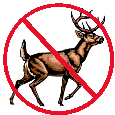USDA National Wildlife Research Center Symposia
Date of this Version
8-1-1995
Abstract
For many herbivorous mammals, oils from conifers are feeding repellents. Our study investigated effects of pine needle oil on feeding and other behaviors of northern pocket gophers. In one-choice feeding trials pocket gophers were offered sweet potato from single feeding stations placed into each subject's home cage. Stations contained either a scent dispenser with pine needle oil or with mineral oil. Pine needle oil did not inhibit food retrieval under these conditions. Responses to pine needle oil and to a control odorant, d-pulegone, were also tested in mazes where subjects were offered choices between two goal boxes, each containing food associated with an odorant. To examine the possibility that pocket gophers avoid any unfamiliar odor because of neophobia, freshly caught animals were tested in a maze offering a choice between goals scented with d-pulegone and goals containing mineral oil. The behavior of the animals in the side of the maze containing pulegone did not differ from their behavior in the side containing mineral oil, indicating indifference to this stimulus. Pine needle oil, however, elicited aversive responses. When one goal box contained pine needle oil, the second mineral oil, subjects were less frequently located in the side of the maze containing pine scent and consumed less food there. Responses of northern pocket gophers to pine needle oil in mazes are similar to those of plains pocket gophers studied earlier under comparable conditions. Results obtained with both species suggest that pine needle oil may be an effective repellent for all species of pocket gophers.
Included in
Behavior and Ethology Commons, Natural Resources Management and Policy Commons, Terrestrial and Aquatic Ecology Commons

